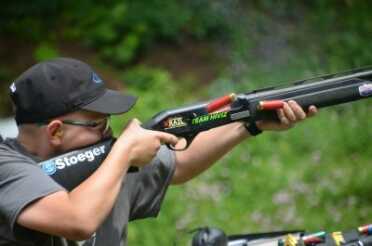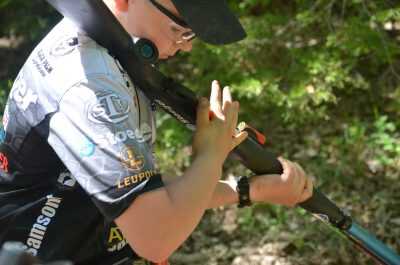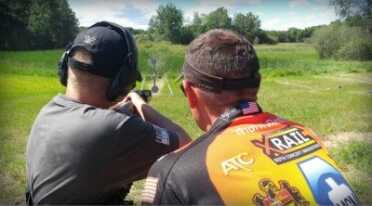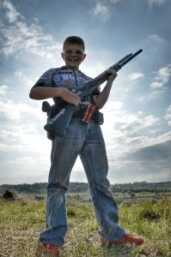Introduction
Shotguns often receive a black eye because of the misconception that they kick and that it takes a lot of body mass behind the gun to handle their recoil. People say they’re not for kids.
I’m here to tell you from experience that not only can kids master shotgun shooting, but they will gain a huge boost in confidence from using them!

A solid stance and good position on the gun, coupled with an understanding of what they can do to manage recoil, will allow kids to enjoy blasting clays, ducks, and everything you let them shoot with a shotgun!
The Kids and Guns Series
- The Basics
- Storage
- Teaching
- Rimfire
- Hunting
- Competitive Shooting
- Shotguns
- Pistols
- Revolvers
- Older kids
- Tactical Kids
Stand Strong
One of the biggest challenges youths face in shooting is handling the recoil. Learning to manage it through mechanical principles is an important part of learning to shoot any gun.
But for shotguns, it’s really more of a biofeedback loop than strict positional shooting. You need to constantly adjust your body’s response to the recoil to get back on target and keep a good sight picture.
Shooting shotguns while moving and shooting at moving targets takes even more concentration. It’s not about stance, it’s about bodily awareness. Growing kids don’t necessarily have the best bodily awareness, so shooting a shotgun can teach them not just where their muscles are, but how to use them to their advantage!
Start with the Gun
 In order for kids to learn to shoot shotguns, you have to start with the right gun. You have to find or make a gun that fits the shooter!
In order for kids to learn to shoot shotguns, you have to start with the right gun. You have to find or make a gun that fits the shooter!
Cutting the stock short makes it easier for small shooters to bring their gun close to their center of gravity. This makes it possible even for kids to handle 12-gauge shotguns.
We cut about two to three inches off our shotguns for competition and we’ve cut down a wood-stocked 20-gauge that our boys shot when very young by about four to five inches.
Competition shotguns tend to be long, often with magazine tubes that hold ten or more rounds. Err on the shorter side so your youth can hold it up. Build their strength before you weigh them down with a long tube full of shells.
You’ll have to decide what bore shotgun to get as well. Both 12- and 20-gauge shotguns are pretty standard with many available loads including low-recoil shells. There are advantages and disadvantages to both.
Twelve-gauge guns have more reach. The larger payload means more pellets on target at longer distances. For practical shooting, it makes it easier to knock down targets and for clay sports it makes it possible to break pigeons farther out. It’s also easier to load 12-gauge shotguns since they have a bigger loading gate.
Twenty-gauge guns are lighter, and easier to hold up. While they might be easier to hold up than 12-gauge, sometimes the recoil felt can be harsh, because there is not as much weight in the gun to “soak up” the recoil.
Also, when teaching kids to shoot, consider cutting the magazine tube spring a little shorter until they master the motions of loading. You can add a stronger spring later. Most kids will shoot a 20-gauge shotgun for a year or two and outgrow it. Save the 20-gauge for the 10 and under crowd. By about 11 or 12 years old, most kids can handle a 12-gauge. Our 12-year-old shoots my shotgun, with a shortened length of pull without any problems.
Set up your Stance
The next step in teaching kids to shoot is to start from the ground up and build a good stance. Shotgun shooting for an adult is different than a kid. Kids have big heads in relation to their bodies. They’re awkward and don’t have the best balance.
A technically perfect stance might not work best for them. They might need to step the forward leg a bit more forward. So to outline this, we have a little video (see below). Pay attention to our shooters’ feet. The smallest kicks one foot back further.
Despite their differences, they all use their core and keep their face on the stock. That’s what’s really important when shooting. Their shoulders are solidly behind the gun. While their feet might not be perfect, they still face their targets squared and keep their shoulder and body mass behind the gun.
Pick a load that runs without beating you down
Kids needs to shoot rounds that don’t knock them on their butt! Don’t buy a case of high-velocity ammo thinking it will help them to learn to shoot — “If they shoot that, then they can handle anything,” — if it hurts to shoot, a kid might quit. Nobody likes to do something that hurts or scares them.
With lighter practice and low-recoil loads they can shoot more and build some muscle instead of shooting fewer rounds and walking away defeated.
If you are going to take kids hunting, it’s also wise to teach them what the recoil of a turkey load versus a light load is; 1100 versus 1300 feet per second is a big difference! If your kid is dying to hunt turkeys, make sure they shoot a turkey load so they know what to expect and how to hold the gun.
If you’re going to hunt deer with slugs, do the same thing, and make sure they shoot slugs at a reasonably sized target at a distance they are likely to shoot a deer at. This will give them a lot more confidence while hunting.
Practice

Instruction from adults who understand the time it takes for kids to build up strength and an understanding of all the mechanics of shooting a shotgun well will set them off on the right track when it comes to enjoying shotgun shooting.
In order for kids to learn to shoot shotguns well they will need to practice. Practice shouldering the gun and pulling it in.
When shooters don’t hold their shotguns tightly they run the risk of having the stock bounce up and hit them in the face. They can also bruise their shoulder if they are not pulling the gun firmly into their shoulder.
Everyone has a spot on their shoulder, the “pocket,” a nice place right where the gun ought to sit.
Teach them to get their gun in their pocket and their faces down firmly on the stock. It’s important that they use their cores, plant their feet and hold their heads level.
Practice shouldering, shooting, and getting back on target. Practice tracking a clay. And dry-fire practice.
Even if it’s picking up and shouldering the gun 50 times a day, the motion will become more familiar. The next time they go into the duck blind, they might be a little more confident. Enjoying a hunt or a shooting competition is so much easier when you’re not worried about performing with your gear.

Small guns for small people is math, physics and fun rolled together. Don’t turn kids off to shooting by handing them a shotgun that’s too big or too powerful.
Kids might not express anxiety; they might be so excited to hunt they don’t bother mentioning that they forgot what they learned in hunter safety last year. So make sure you take the time to supervise them in dry fire and handling their gun, as well as practicing on the range.
Set up a fake blind with your lawn furniture and teach them different ways to mount the gun from a blind. Even experienced shooters benefit from that sort of practice. For kids who might be tentative about going on their first hunt, a little make believe can go a long way in putting them at ease. It might make the rest of your family want to join in too, so be careful just how much fun you make it!
Conclusion
Learning to handle a shotgun and becoming proficient with the skills necessary to do well will build confidence with firearms, make your shooting competition or hunt more enjoyable and set your kids up to embrace challenges in life. So get them outside and go shoot!
